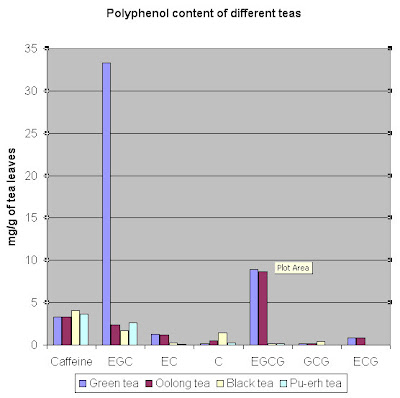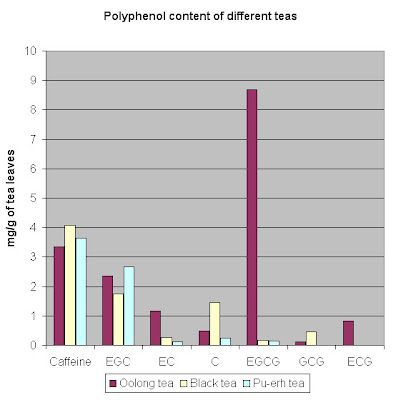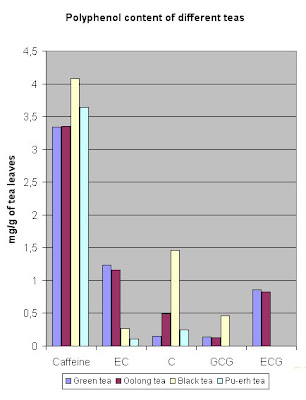Caffeine and Polyphenol Contents of Green Tea, Black Tea, Oolong Tea & Pu-erh Tea
If you've ever wondered about the polyphenol and caffeine content of different types of tea, this post is for you.
The data in the following figures is by Kuo et al. who compared the effects of green tea, black tea, oolong tea and pu-erh tea on rats. I'll review the rest of the paper later and just present the polyphenol content of various teas in this post.
The first graph has all four tea varieties, major catechins (the most biologically active group of tea polyphenols) and caffeine content listed. The catechins are epigallocatechin (EGC), epigallocatechin gallate (EGCG), epicatechin gallate (ECG), epicatechin (EC), gallocatechin (GC) and catechin (C).

EGCG and EGC are clearly the most abundant catechins. Green tea takes the cake with the highest amount of both. None of the other three come even close to green tea's EGC content.
The second graph has green tea removed from it to give us a better look at how the rest of the teas fare.

Here oolong tea stands out with its high EGCG content. A lot of the studies on the health benefits of tea concentrate on EGCG, so oolong tea seems like a healthy choice too. It also has the least amount of caffeine along with green tea.
The third and last graph has EGCG and EGC removed to give a better view of the other catechins.

Green tea and oolong tea are the winners in the EC and ECG categories, but when it comes to GCG and plain old C, it's black tea that is number one.
Which tea is the healthiest?
Based on the figures above, the healthiest choice in terms of catechin content is green tea. Oolong tea comes in second. As you can see from the graphs, the more fermentation the tea has gone through, the less catechins it has.
Keep in mind, however, that not all of the health benefits of tea come from catechins. Thanks to the catechin-destroying fermentation process, black tea has more theaflavins, which have their own health effects. Remember also that these numbers are from one study only, so you shouldn't rely on them blindly.
What are oolong tea and pu-erh tea?
I'm sure you already know the difference between green tea and black tea, but what about oolong tea and pu-erh tea? Oolong tea is really just a mixture between green and black tea: whereas green tea has gone through minimal fermentation and black tea is fermented, the length of fermentation when producing oolong tea is somewhere in the middle.
Pu-erh tea, named after the region where it was first harvested, is traditionally made with leaves from old wild tea trees. Pu-erh is a post-fermented tea, which means it has undergone a period of aging in open air. The aging may take from months to years and makes pu-erh a highly sought-after tea.
For more information on tea and health, see these posts:
How Black Pepper Increases the Bioavailability of the Healthiest Green Tea Catechin
Drinking 10 Cups of Green Tea Daily and Not Smoking Could Add 12 Years to Your Life
Green Tea, Black Tea & Oolong Tea Increase Insulin Activity by More than 1500%
Black Tea is More Effective in Activating Superoxide Dismutase (SOD) than Green Tea









0 kommenttia:
Post a Comment